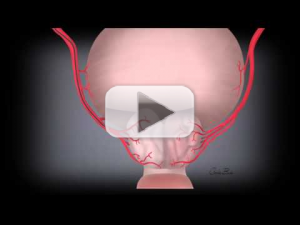Prostatic artery embolization (PAE) is performed to help improve urinary symptoms caused by an enlarged prostate, or benign prostatic hyperplasia (BPH), without the risk of sexual side effects.

Since 2013, vascular interventional radiologists at University of North Carolina Hospitals in Chapel Hill have been successfully treating enlarged prostate (benign prostatic hyperplasia) using a catheter-based treatment called prostatic artery embolization (PAE).
The UNC Center for Heart & Vascular Care is one of the first in the nation to use PAE to treat men with an enlarged prostate, and according to Charles Burke, MD, Associate Professor, Radiology, and Division Chief, Vascular Interventional Radiology (VIR), “I am not aware of anyone in North Carolina who is doing this procedure.”
Benign prostatic hyperplasia (BPH) is the most common noncancerous prostate problem, occurring in most men by the time they reach their 60s. Symptoms of BPH can include slow, interrupted, or weak urinary stream; urgency with leaking or dribbling; and frequent urination, especially at night.
The PAE procedure is minimally-invasive for patients, requiring no open surgery. Typically, patients experience little to no pain, no hospital admission, and for many patients, they see improvement within one month. The physicians at UNC have received thanks from many patients who have been treated for BPH with PAE. They are very pleased with the vast improvement in their quality of life.
PAE is performed through a small puncture in the groin or forearm. A catheter is inserted through the artery and directed toward the prostate. Once the catheter is positioned in the artery supplying blood to the prostate, tiny particles are injected that plug up the artery, blocking blood flow. This is called embolization. The process is then repeated on the other side, most commonly through the same original puncture. The procedure can take anywhere from 1-3 hours, depending on the location and size of the prostatic arteries.
The PAE procedure blocks the blood flow to the areas of the prostate that are most affected by BPH, resulting in death, or necrosis, of isolated areas. Because it is impossible to block all of the blood flow to the prostate, it does not die completely. These areas of necrosis cause the prostate to initially be softer, alleviating some of the pressure that is causing blockage of the urine. Over several months, the body’s immune system reabsorbs the dead tissue and replaces it with scar. This scar tissue slowly contracts resulting in shrinkage of the prostate. Over a six- month period, the prostate will shrink by 20-40%, resulting in improved and less frequent urination.
Originally developed in Europe and South America, the PAE procedure is now being studied in the United States. UNC Interventional Radiology is excited to be contributing to this research through a clinical research study led by principal investigator Ari Isaacson, MD, assistant professor, division of Vascular Interventional Radiology.
The UNC study is designed to assess the effectiveness of PAE in men with severe BPH and refractory lower urinary tract symptoms (LUTS). Study participants are being recruited from UNC Urology clinics as well as referring providers.
“The study is for men who have a large prostrate of over 80 grams,” explains Dr. Isaacson. “When the prostate becomes this large, transurethral procedures such as TURP become more difficult, resulting in many men having to undergo open surgery. Because of the risks associated with this surgery, we would like to investigate a minimally-invasive alternative that in other studies has yet to demonstrate any risk of significant bleeding or sexual dysfunction.”
Charles Burke, MD, Associate Professor, Radiology, and Division Chief, Vascular Interventional Radiology, says, “It should be noted that although PAE is a new procedure, the skills involved are not new to Interventional Radiology. We regularly use very similar techniques and equipment to treat uterine fibroids. Given the available data, we are dedicated to bringing this procedure to patients at UNC.”
The PAE video includes additional information about the procedure and please contact Dr. Isaacson for a physician referral or self-referral. For the enrollment requirements for the clinical trial at UNC, contact Dr. Isaacson or Shanah Kirk.